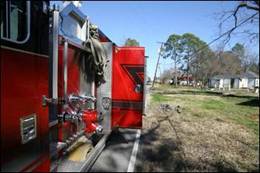

|
“Our Mission Is To Provide Quality Public Service, Public Education, and Professional Emergency Response” |
|
Monroe Fire Department 1810 Martin Luther King Blvd Monroe, LA (318)329-2474 Jimmie R. Bryant, Fire Chief |
| EMSNetwork Latest News |



|
International Association of Fire Chiefs |
|
International Association of Firefighters |

|
National Association For Search and Rescue |

|
National Association of Emergency Medical Technicians |

|
National Fire Fighter Near-Miss Reporting System |

|
Preparation Each shift at the Monroe Fire Department formally begins at 8am each morning. At this time each Company Officer (Fire Captain) begins the shift by assessing the crew on the apparatus, the status of the apparatus and its equipment, and any training, public relations events, or utility or truck maintenance that may be scheduled for the day.
The Apparatus Operater (Lieutenant, Fire Driver), together with the firefighters (Privates and Recruits) assigned to the apparatus, assess the readiness of the unit. This includes opening each compartment and pocket, comparing the contents of each to a predefined equipment list, insuring all contents are present or otherwise accounted for.
|
|
Fire Suppression—The Life Cycle of a Structure Fire Response |
|
Next: Alerting and Response |

|
Photo by The News Star |
|
Equipment assigned to the apparatus, such as cutting saws, positive pressure ventilation (PPV) fans, hydraulic tools, and each self-contained breathing apparatus (SCBA) is individually operated and tested to insure readiness. Any needed maintenance, such as cleaning, refueling, changing blades, or refilling is done at this point.
For engine companies, the Apparatus Operator will also test the fire pump. The fire pump receives static water from the built-in 500 gallon water tank, or from the four-inch supply hose line connected to the fire hydrant, and pressurizes it to send to the various fire attack lines and discharge ports on the truck. During this test, the driver engages the pump, charges the pump with water from the tank, throttles the engine to build pressure in the pump, insures there is appropriate discharge pressure on the discharge side of the pump, and tests the pressure relief valve. He or she will also insure the diesel tank for the motor and the water tank for the fire pump are both full. Also, the fluid levels in the motor are checked, including the engine oil, transmission fluid, power steering fluid, and radiator water level.
For ladder companies, the outriggers are set and the aerial ladder is raised to insure the hydraulics, the lifting mechanisms, and the stabilizers are working to specification.
For the rescue companies, the hydraulic spreader and cutter are charged and operated under stress to check for any leaks in the hoses and couplings, and to insure they are ready at full power for any kind of a vehicle rescue.
Finally, the apparatus is check for cleanliness, both inside the cab and outside. The truck is washed and detailed if necessary to insure cleanliness and a professional appearance. Each apparatus is regularly waxed with cleaner wax, polish, buffed, and has finish wax applied to protect the clean appearance and to insure a “new” appearance for many years to come.
This process is repeated every morning at 8am at every shift change, seven days a week, every day of the year, to insure each unit’s readiness for an emergency.
|
